B2 First story writing in a nutshell
- Mandatory task: no
- Word count: 140-190
- Main characteristics: engaging, interesting, well-structured
- Register: depending on the story
- Structure: beginning, main part, ending
- Language: adjectives/adverbs, past verb forms, direct speech, time expressions
- Example
A day to forget – a day to remember
Jerry read the email and decided to go to the shopping centre immediately. He hadn’t slept well at all and was feeling quite nervous that morning and he didn’t want to let his grandma’s wish to buy some milk ruin his day.
He dragged himself into his old and dirty car and set off in the direction of Central Mall. Not even ten minutes later, he had a flat tire so he spent the next hour putting on the spare before he was able to continue his dreadful journey.
At the shopping centre, he walked absent-mindedly into a family and their son fell on his knee. “I’m sorry,” was the only thing he could say, but the boy’s little sister replied, “This is a gift for you,” and gave him a little piece of paper. Jerry simply stuffed it in his jacket pocket and walked off as quickly as he could.
Back at home, he just wanted to go to bed, when he dropped the girl’s paper on the floor. Jerry couldn’t believe his eyes. It was a scratch card with a win of €50,000! “Not such a bad day after all,” Jerry thought with a smile and he poured himself a steaming cup of coffee.
Introduction
A story is usually written for an English language magazine or website for teenagers. The main purpose is to engage the interest of the reader. Effective answers have a clear storyline which links coherently to the first sentence, successfully uses the prompts provided and demonstrates a sound grasp of narrative tenses.
from: Cambridge English B2 First for Schools Handbook for Teachers
Stories are part of the second task in the B2 First Writing exam and they are exclusive to B2 First for Schools. In this variant of the test, there are no report tasks but instead, candidates have the choice between articles, reviews, emails/letters and the topic of this article – stories.
Feel free to check out my other posts on the different B2 First writing tasks by clicking on any of the links below.
- Cambridge B2 First (FCE): How to Write an Email/Letter
- Cambridge B2 First (FCE): How to Write an Essay
- Cambridge B2 First (FCE): How to Write a Review
- Cambridge B2 First (FCE): How to Write a Report
- Cambridge B2 First (FCE): How to Write an Article
- Cambridge B2 First (FCE): How to Write an Email/Letter
- Cambridge B2 First (FCE): How to Write an Essay
Stories might be the most underestimated task in the whole writing exam as they are only part of B2 First for Schools.
They are discussed fairly little in preparation classes even with teenagers who are more likely to run into this type of text in their test. I think that stories are fun to write because they are probably the most open task type in terms of creativity. On the other hand, this level of freedom can also pose a challenge for many so story tasks can be time-consuming and difficult.
What a typical story task looks like
As with all the other task types, stories can be broken down in the same fashion every time you want to write one.
You should analyse the task carefully in order to collect as much information as you can. This way, the writing process itself is smooth sailing from start to finish.
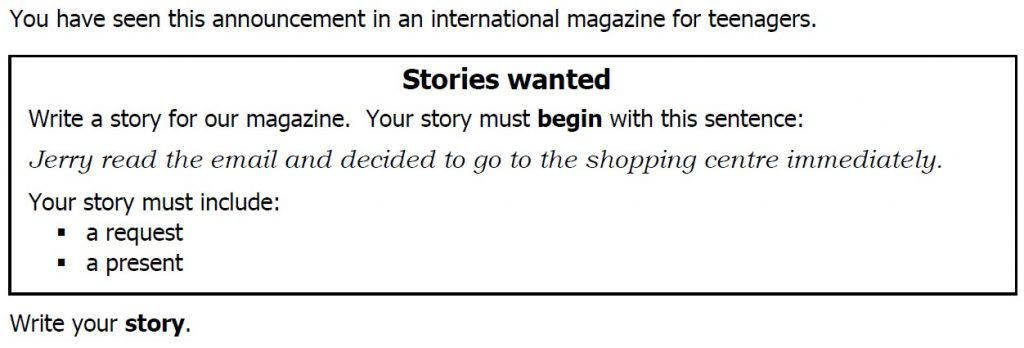
At first sight, this could be like any other task for an article or a review, but we need to look a little bit more closely to see what is unique about stories.
As always, you should go through task analysis step by step and ask yourself a few specific questions that will help you get all the information you need.
- What is the topic of my story?
- What exactly do I have to include in the story?
- Who is going to read my story?
The first question is fairly straightforward and can always be found by looking at the sentence given in the task.
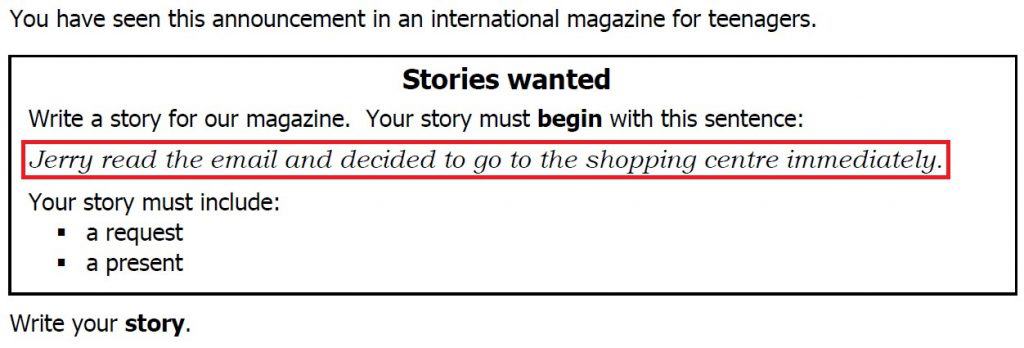
In our example, the story needs to be about someone named Jerry you received an email and decided to go to the local shopping centre. All we get is a name a a little bit of a kickstart to the plot, but that’s it.
Every story task looks similar so always focus on the given sentence to find out more about the topic.
The second question is more specific and goes into more detail. Again, let’s see what we can extract from our example task.
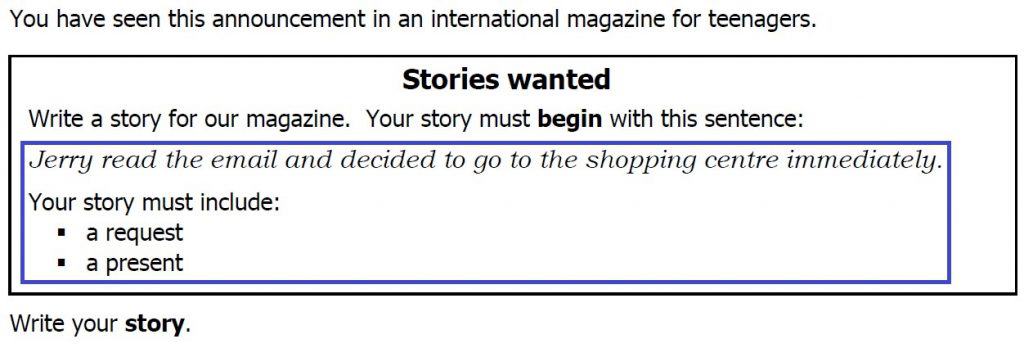
The very first thing we have to include is the sentence about Jerry and the email. There is always a sentence which must be used as the very first sentence of your story. Don’t forget or change the sentence. Start your story with it as it is.
There are, however, two more ideas that you always have to write into your story. In this case, we must include a request and a present. The role these things play in your story is entirely up to you, but they should play a central role and be important parts of the plot.
The third and final question looks at the reader of the story. Remember that you never write for the examiner or your teacher but always for someone specified in the task.
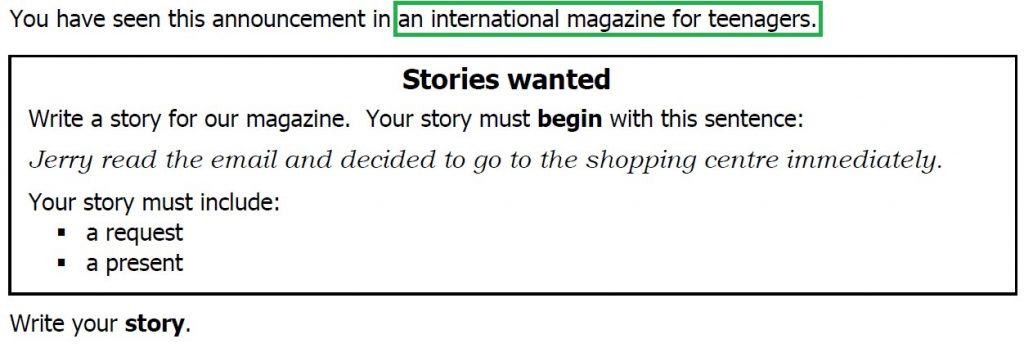
Here, we write for the readers of an international magazine for teenagers, which means that teenagers from different countries are going to read your story.
As B2 First for Schools is designed to cater to people in that age group so we are writing for peers. Therefore, we can use rather informal language, but as you will see later on, register is not the most important aspect of a story compared to, for example a letter of application where a formal style is one of the key features. Stories already include so much useful language that choosing the correct register is secondary.
Remember, every story task looks similar and you can go to the same places in each task to find key pieces of information that you can use to set yourself up for success. Simply ask yourself the three questions described in this part and you shouldn’t have a problem with task analysis.
How to organise a story in B2 First for Schools
When we try to put our story in a well-organised structure, we can simply look at every story ever written in the history of humankind and we will find that 99% of them look like this:
- Beginning
- Main part
- Ending
This pattern can be further broken down by splitting the main part into two or even three paragraphs, but we’ll get to that in a second. First, keep the above structure in mind for the future.
At the beginning of a story, we are usually introduced to the main character(s) and learn a little bit about the background of the plot. We might also find out about how the main character(s) feel right before the action starts.
The main part includes the main actions and parts of the plot. Here, the story progresses the furthest, but we normally don’t come to a conclusion yet.
The ending does what the name suggests. It brings the plot to a conclusion and ends the story in an appropriate and satisfying way. You don’t want to keep your readers guessing too much because there won’t be a sequel. You are not writing The Avengers Part 87 but a standalone story.
Now, however, let’s go back and see how we can apply all of the above to our specific task.

Luckily, the first sentence is already there for you, but we obviously need to be a little bit more creative. Think about how Jerry might have felt in this situation and what might have happened in the lead up to him reading the email.
I usually like to introduce the two topic points in the main part of the story, but they could already appear in the beginning. Again, this is completely up to you, which makes stories exciting and stressful to write at the same time.
Either way, in order to fill the main part of your story with life, try to come up with ideas of what could have happened on Jerry’s way to the shopping centre and when he was there.
Finally, we need to bring everything together in a good ending. You can try to end the story in an unexpected or funny way, but it is definitely more important to come to a meaningful and logical ending at all.
I find it quite often with my own students that they simply cut off the plot at the end of the main part, which leaves the reader not fully informed. So, make the reader (and examiner) happy and give your story the ending it deserves.
Always make a plan for your story
If I could give my students just one piece of advice for the writing exam in B2 First, I would tell them to always make a plan before starting to write.
It only takes a few minutes, but can save you a lot more towards the end on the test when you are in time trouble and don’t know what to do.
A plan helps you stay on task and all you have to do is follow it and fill the page with life.
My plan for our example looks like this:
- Beginning: nervous; hadn’t slept well; request in the email –> buy milk for grandma
- Main paragraph 1: flat tyre; had to change it; wasted time
- Main paragraph 2: at the shopping centre; accident with family; little girl gave him piece of paper
- Ending: piece of paper was scratchcard; won €50,000
Just from my plan, you can already guess what the story will look like even though I didn’t add a lot of information. Making the plan took me three minutes, but I only need to connect the dots now and get started.
The different parts of a story in B2 First
In this part, I’m going to take you deep down the rabbit hole. We are going to go through the different parts of a great story with the help of our example task.
You will learn more about good content as well as useful language in each part.
Beginning
As I mentioned earlier, the beginning of a story fulfills two tasks. It introduces the reader to the main character(s) and sets the scene. We can include previous events and background information so we can started.
One of the main criteria in a story is the correct use of narrative verb forms. These are different past verb forms, each of which has a distinct function in a story. We want to use past simple for the main events, past continuous for background actions and past perfect simple and continuous for things that happened before the main events.
Sounds complicated, but with some practice you’ll get better at it. If the names of these verb forms don’t ring a bell at all, you should definitely look into them as they are not only important in the writing test but also in Reading & Use of English and Speaking.
In addition to this particular grammar point, we want to make the beginning interesting from the get-go using some engaging adjectives/adverbs and other helpful expressions.
A day to forget – a day to remember
Jerry read the email and decided to go to the shopping centre immediately. He hadn’t slept well at all and was feeling quite nervous that morning and he didn’t want to let his grandma’s wish to buy some milk ruin his day.
I gave my story a nice title. Every good story has a title so yours should have one as well, but don’t worry too much. It can be short and doesn’t have to be anything amazing. Just make sure that you include it.
I also used a mix of verb forms (blue) to show the main events, background actions and things that had happened before the main storyline.
On top of that, I included a few adjectives and adverbs which help make the story come to life (red).
Keep these things in mind when you start your story and you will be off to a good start.
Main part
The main part of a story is what the name says: the most important part which includes the majority of information.
Here we find most of the main events and the plot progresses between the beginning and ending.
Your focus in this part should lie on a logical order of events while keeping the reader engaged and interested.
We achieve this, once again, by using the correct verb forms (mostly past simple as we are in the middle of the main events) as well as other stylistic features, some of which we’ve discussed earlier and others that you can see in the example paragraphs below.
He dragged himself into his old and dirty car and set off in the direction of Central Mall. Not even ten minutes later, he had a flat tire so he spent the next hour putting on the spare before he was able to continue his dreadful journey.
At the shopping centre, he walked absent-mindedly into a family and their son fell on his knee. “I’m sorry,” was the only thing he could say, but the boy’s little sister replied, “This is a gift for you,” with a smile and gave him a crumpled piece of paper. Jerry simply stuffed it in his jacket pocket and stormed off as quickly as he could.
We’ve got quite a lot to unpack here.
First and foremost, if you take a step back and read the paragraphs without paying attention to all the colourful stuff, you will see that there is a logical and chronological progression. Jerry leaves his house, has a flat tyre, makes it to the shopping mall and runs into the family. The girls gives him the paper and he leaves.
I guess this all makes sense, but I still used certain expressions of place and time (orange) that support this idea that there is a sequence of events. Little remarks like ‘before’ or ‘next’ can make it so much easier for the reader to follow the story so make sure you use them.
Another feature that we haven’t discussed yet is direct speech (green). By using direct speech we can bring the characters to life and the reader can identify with them more easily.
Finally, I continued with good and engaging past verb forms (blue) as well as adjectives/adverbs (red) which bring colour to the things and people you describe.
Ending
The very last part of every amazing story is a great ending. Here, we tie everything together and bring the events to a conclusion.
It is your decision if you want to give your story a happy ending or not, but make sure that it ends in some way. Don’t just stop after the main part and leave your reader with questions. Send them off with a smile on their face or tears in their eyes.
Back at home, he just wanted to go to bed, when he dropped the girl’s paper on the floor. Jerry couldn’t believe his eyes. It was a scratch card with a win of €50,000! “Not such a bad day after all,” Jerry thought with a smile and he poured himself a steaming cup of coffee.
I tried to bring a little surprise to the ending of my story and turn Jerry’s terrible day into a good one.
You can find the different stylistic features I used in different colours again. Past verb forms are blue, direct speech green, expressions of place and time orange and other interesting language and punctuation red.
Don’t stop being awesome towards the end of your story. Stay consistent and use good language throughout the whole text. That’s what the examiners want to see and that’s you you will give them if you follow the tips in this article.
Useful language for stories in B2 First
In the last part, I showed you some of the main ideas to improve your story writing. Using these language features can give you an edge over other candidates and impress your examiner. Always remember that an examiner checks dozens of texts per day and it is important to stand out with your pieces of writing.
So, below I’ve listed the different types of useful language with a few examples in each category. Obviously, this is not a complete list, but you can add expressions and adjust them to your needs.
| Category of useful language | Examples |
|---|---|
| Narrative (past) verb forms: past simple/continuous, past perfect simple/continuous | He woke up and took a shower. (past simple) It was raining outside when she arrived. (past continuous) When they cam home they saw that someone had broken the window. (past perfect simple) She had been driving for many hours when decided to stop for the night. (past perfect continuous). |
| Expressions of place and time | when, while, then, next (day, week, month, etc.), before, ten minutes later back at home, at the shopping centre, in the city centre |
| Adjectives/adverbs and other engaging language | He dragged himself into his old and dirty car. (adjectives) Jerry simply stuffed it in his jacket pocket. (adverbs) Jerry couldn’t believe his eyes. (engaging expressions) |
| Direct speech | “Not such a bad day after all,” Jerry thought … (direct speech) |
How your B2 First story is marked
The process of marking candidates’ writing tasks in B2 First is an involved and quite complicated process. There are different criteria the examiners have to look at and even for teachers, it can be almost overwhelming to work their way through all the information.
I wrote an article on the topic that I hope will help students and teachers alike to better understand the marking process and to use it in order to improve their writing and/or teaching skills and insight.
Simply click here to find out more.
Time to become a storyteller
In this article, I’ve shared with you everything I know about how to write an excellent story in B2 First for Schools.
Take my advice and start practising. If you have any questions or problems, feel free to leave a comment and I will reply as quickly as I can.
Lots of love,
Teacher Phill 🙂


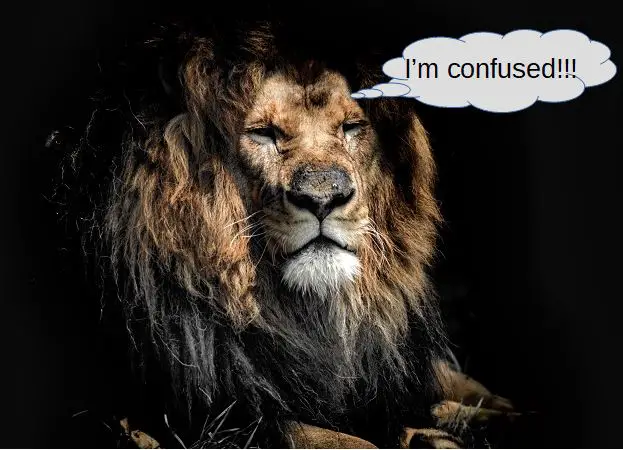

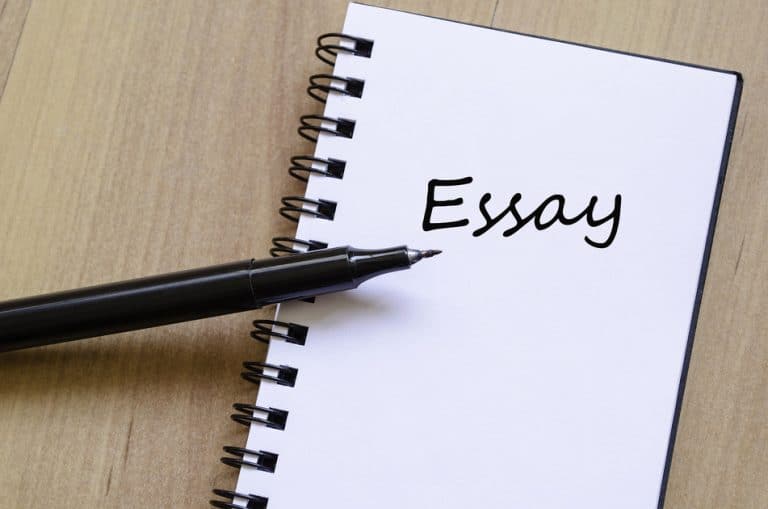

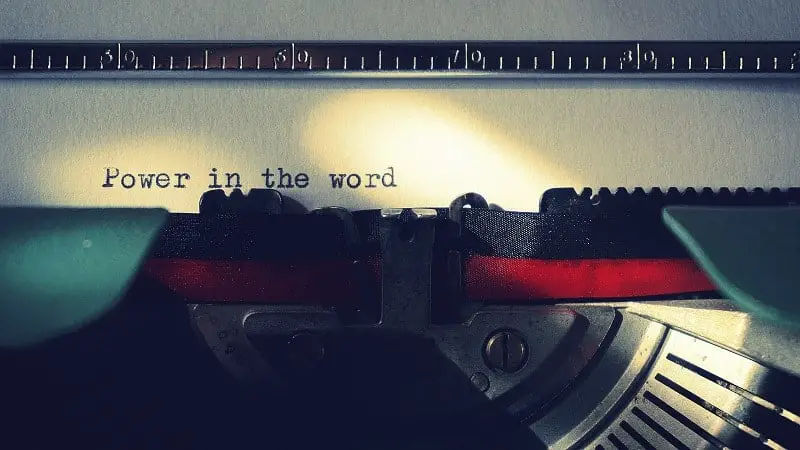

I am in fact glad to read this weblog posts which consists of lots of useful facts, thanks for providing such data.
Thanks a lot! Best explanatatory article I’ve read about writing a story. I’ll definitely check your other guides. Love the coloring and comments to each part!
Thank you so much!!! This is excellent…easily explained…everything included
A must to have when teaching…FCE!!